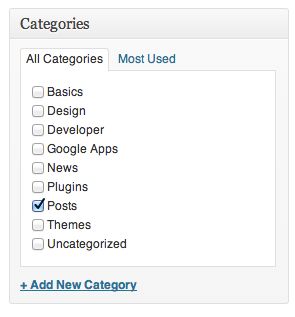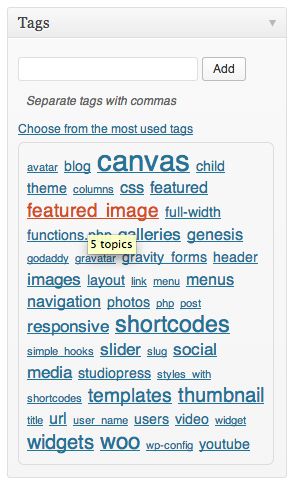Categories are like fruits and vegetables, tags could be squashes and nuts.

Categories are broader and “bigger” than tags.
Let’s use a supermarket as an analogy. Hopefully this will help you organize your site so the reader (and you!) can find what they’re looking for.
Categories
There’s the supermarket itself, that’s your website. So we already know it’s about food. Next is categories. You walk into the supermarket and what can you see easily? Maybe those huge displays on the far walls: Bakery, Grocery, Deli, and Butcher, etc. They are the main distinguishing factors for the foods available. Of course, you could also use a completely different set of categories, you could have: Fresh, frozen, processed, and non-food goods. It’s up to you. One nice feature of categories is that they can be hierarchical, so you can have a category called Grocery, but then sub categories called Fruits and another called Vegetables.
- Bakery
- Grocery
- Fruits
- Vegetables
- Butcher
- Specials
Keep in mind that a post can be categorized in multiple categories so our Gluten-Free Rice Bread might be under Bakery but also Specials or something non-food related.

Tags can be used more liberally and sprinkled on your posts.
Tags
Tags then could be considered as “cross-category” indexing tools. Let’s say you wanted to label products as gluten free, healthy, sugar free, or even something with ingredients: rice, oats, flour, dairy, non-dairy, etc.
Posts
Posts are then the actual products in the store. Don’t forget that these can also be descriptive. In our example, Gluten-Free Rice Bread. It would be categorized in the Bakery category but then also tagged as gluten-free as well as rice and non-dairy. If you used a category called Specials, you could check the Specials category box while it was on Special and uncheck when it was not.
- Website: supermarket
- Categories: bakery, grocery, bakery, butcher, etc.
- Tags: gluten-free, dairy, drinks, fresh, etc.
- Posts: Tomatoes, head of chard, or 6-pack of Franziskaner Hefe-Weizen, etc.
You can always change the category/categories of a post later on, but do be careful if you’re using categories in your post permalink structure because if you change the category of a post later it might change the URL of that post and cause trouble.
As you can tell, there are lots of ways (millions to be exact) of ways to use categories, tags, and post names to organize your content. Keep working at it, update your categories and tags, see what works best. If you have too many categories, trim them down at some point, maybe some of them could be tags.
Play it by the Numbers
One last tip on how to use categories, tags, and posts. After you have many posts on your site, see what the count “ratio” is like. Let’s say you have 100 posts in 5 categories and 20 tags. Is there a category that only has 2 posts? Maybe it should be a tag. Or maybe delete that category altogether and just categorize those posts in another category and tag combination.


[…] Categories and Tags (Jul 29) […]
Very helpful! Thank you!